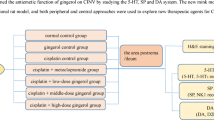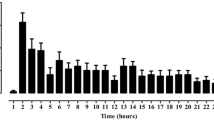Abstract
Purpose
Nausea/vomiting are significant side effects associated with the use of chemotherapy in cancer patients. Treatment of nausea/vomiting caused by cisplatin, a potent chemotherapeutic agent and one of the most emetogenic stimuli, requires a combination of different antiemetic drugs. In this study, we investigated the effects of Scutellaria baicalensis, an antioxidant herbal medicine, on cisplatin-induced nausea using a rat model.
Methods
Rats react to emetic/nausea-producing stimuli, such as cisplatin, with altered feeding habits, manifested by pica or increased consumption of kaolin (a type of clay). We measured pica in rats to quantify cisplatin-induced nausea, and to evaluate the antinausea effect of pretreatment with S. baicalensis extract (SbE) given intraperitoneally.
Results
Cisplatin at 3 mg/kg induced significant pica accompanied by reduced food intake, suggesting the presence of nausea. Hence, this cisplatin dose was selected for testing the antinausea activity of SbE. Cisplatin-induced pica decreased significantly when animals were pretreated with SbE at doses of 1 mg/kg and 3 mg/kg (P<0.01). At a higher SbE dose (10 mg/kg), kaolin consumption increased, rather than further decreased, and was significantly different from that in the groups treated with low SbE doses.
Conclusions
SbE pretreatment decreased cisplatin-induced kaolin intake in the rat model of simulated nausea, suggesting that SbE and its active constituent(s) may play a therapeutic role in chemotherapy-induced emesis. Absence of therapeutic effect at the highest tested SbE dose could have been a result of prooxidant activity often associated with excess antioxidant concentration.






Similar content being viewed by others
References
Pendergrass KB (1998) Options in the treatment of chemotherapy-induced emesis. Cancer Practice 6:276–281
Grunberg SM, Hesketh PJ (1993) Control of chemotherapy-induced emesis. N Engl J Med 329:1790–1796
Bartlett N, Koczwara B (2002) Control of nausea and vomiting after chemotherapy: what is the evidence? Intern Med J 32:401–407
Conklin KA (2000) Dietary antioxidants during cancer chemotherapy: impact on chemotherapy effectiveness and development of side effects. Nutr Cancer 37:1–18
Sodhi A, Gupta P (1986) Increased release of hydrogen peroxide (H2O2) and superoxide anion (O−2) by murine macrophages in vitro after cisplatin treatment. Int J Immunopharmacol 8:709–714
Torii Y, Mutoh M, Saito H, Matsuki N (1993) Involvement of free radicals in cisplatin-induced emesis in Suncus murinus. Eur J Pharmacol 248:131–135
Torii Y, Saito H, Matsuki N (1994) Induction of emesis in Suncus murinus by pyrogallol. A generator of free radicals. Br J Pharmacol 111:431–434
Hannemann J, Baumann K (1988) Cisplatin-induced lipid peroxidation and decrease of gluconeogenesis in rat kidney cortex: different effects of antioxidants and radical scavengers. Toxicology 51:119–132
Schworer H, Racke K, Kilbinger H (1991) Cisplatin increases the release of 5-hydroxytryptamine from the isolated vascularly perfused small intestine of the guinea-pig: involvement of 5-HT3 receptors. Naunyn Schmiedebergs Arch Pharmacol 344:143–149
Richardson MA (1999) Research of complementary/alternative medicine therapies in oncology: promising but challenging. J Clin Oncol 17:38–43
Shao Z-H, Li C-Q, Vanden Hoek TL, Becker LB, Schumacker PT, Wu JA, Attele AS, Yuan C-S (1999) Extract from Scutellaria baicalensis Georgi attenuates oxidant stress in cardiomyocytes. J Mol Cell Cardiol 31:1885–1095
Mitchell D, Wells C, Hoch N, Lind K, Woods SC, Mitchell LK (1976) Poison induced pica in rats. Physiol Behav 17:691–697
Takeda N, Hasegawa S, Morita M, Matsunaga T (1993) Pica in rats is analogous to emesis: an animal model in emesis research. Pharmacol Biochem Behav 45:817–821
Takeda N, Hasegawa S, Morita M, Horii A, Urio A, Yamatodani A, Matsunaga T (1995) Neuropharmacological mechanisms of emesis ll. Effects of antiemetic drugs on cisplatin-induced pica in rats. Methods Find Exp Clin Pharmacol 17:647–652
Rudd JA, Yamamoto K, Yamatodani A, Takeda N (2002) Differential action of ondansetron and dexamethasone to modify cisplatin induced acute and delayed kaolin consumption ("pica") in rats. Eur J Pharmacol 454:47–52
Kimura Y, Kubo M, Tani T, Arichi S, Okuda H (1981) Studies on Scutellariae radix. IV. Effects on lipid peroxidation in rat liver. Chem Pharm Bull 29:2610–2617
Kimura Y, Okuda H, Tani T, Arichi S (1982) Studies on Scutellariae radix. VI. Effects of flavonone compounds on lipid peroxidation in rat liver. Chem Pharm Bull 30:1792–1795
Cubeddu LX (1996) Serotonin mechanisms in chemotherapy-induced emesis in cancer patients. Oncology 53 [Suppl 1]:18–25
Cubeddu LX, O'Connor DT, Parmer RJ (1995) Plasma chromogranin A: a marker of serotonin release and of emesis associated with cisplatin chemotherapy. J Clin Oncol 13:681–687
Cubeddu LX (1992) Mechanisms by which cancer chemotherapeutic drugs induce emesis. Semin Oncol 19:2–13
Fukui H, Yamamoto M, Ando T, Sasaki S, Sato S (1993) Increase in serotonin levels in the dog ileum and blood by cisplatin as measured by microdialysis. Neuropharmacology 32:959–968
Lindley C, Blower P (2000) Oral serotonin type 3-receptor antagonists for prevention of chemotherapy-induced emesis. Am J Health Syst Pharm 57:1685–1697
Matsuki N, Torii Y, Saito H (1993) Effects of iron and deferoxamine on cisplatin-induced emesis: further evidence for the role of free radicals. Eur J Pharmacol 248:329–331
Andrews PL, Davis CJ, Bingham S, Davidson HIM, Hawthorn J, Maskell L (1990) The abdominal visceral innervation and the emetic reflex: pathways, pharmacology, and plasticity. Can J Physiol Pharmacol 68:325–345
Yuan CS, Barber WD (1993) Area postrema: gastric vagal input from proximal stomach and interactions with nucleus tractus solitarius in cat. Brain Res Bull 30:119–125
Huang KC (1999) The pharmacology of Chinese herbs, 2nd edn. CRC Press, Boca Raton, pp 385–386
Gupta YK, Sharma SS (2002) Involvement of 5-HT1A and 5-HT2 receptor in cisplatin induced emesis in dogs. Ind J Physiol Pharmacol 46:463–467
Liao JF, Jan YM, Huang SY, Wang HH, Yu LL, Chen CF (1995) Evaluation with receptor binding assay on the water extracts of ten CNS-active Chinese herbal drugs. Proc Natl Sci Counc Repub China B 19:151–158
Vanden Hoek TL, Shao ZH (2003) Herbal antioxidants: cardiovascular potential and danger. In: Yuan CS, Bieber EJ (eds) Textbook of complementary and alternative medicine. Parthenon, New York, p 52
Hill RP, Lubarsky DA, Phillips-Bute B, Fortney JT, Creed MR, Glass PS, Gan TJ (1990) Cost-effectiveness of prophylactic antiemetic therapy with ondansetron, droperidol, or placebo. Gen Pharmacol 21:1–10
Campos D, Pereira JR, Reinhardt RR, Carracedo C, Poli S, Vogel C, Martinez-Cedillo J, Erazo A, Wittreich J, Eriksson LO, Carides AD, Gertz BJ (2001) Prevention of cisplatin-induced emesis by the oral neurokinin-1 antagonist, MK-869, in combination with granisetron and dexamethasone or with dexamethasone alone. J Clin Oncol 19:1759–1767
Singh L, Field MJ, Hughes J, Kuo BS, Chauhan NS, Tuladhar BR, Wright DS, Naylor RJ (1997) The tachykinin NK1 receptor antagonist PD 154075 blocks cisplatin-induced delayed emesis in the ferret. Eur J Pharmacol 321:209–216
Sanger GJ, Wardle KA (1994) Constipation evoked by 5-HT3-receptor antagonism: evidence for heterogeneous efficacy among different antagonists in guinea pigs. J Pharm Pharmacol 46:666–670
Wolfe SG, Chey WY, Washington MK, Harding J, Heath AT, McSorley DJ, Dukes GE, Hunt CM (2001) Tolerability and safety of alosetron during long-term administration in female and male irritable bowel syndrome patients. Am J Gastroenterol 96:803–811
Ballard HS, Bottino G, Bottino J (1992) Ondansetron and chest pain. Lancet 340:1107
Marin J, Ibanez MC, Arribas S (1990) Therapeutic management of nausea and vomiting. Gen Pharmacol 21:1–10
Cipak L, Rauko P, Miadokova E, Cipakova I, Novotny L (2003) Effects of flavonoids on cisplatin-induced apoptosis of HL-60 and L1210 leukemia cells. Leuk Res 27:65–72
Acknowledgement
The authors would like to thank Spring A. Maleckar for her technical assistance.
Author information
Authors and Affiliations
Corresponding author
Additional information
This work was supported in part by NIH grants R01 CA79042, P30 CA14599, and R21 AT00381.
Rights and permissions
About this article
Cite this article
Aung, H.H., Dey, L., Mehendale, S. et al. Scutellaria baicalensis extract decreases cisplatin-induced pica in rats. Cancer Chemother Pharmacol 52, 453–458 (2003). https://doi.org/10.1007/s00280-003-0694-9
Received:
Accepted:
Published:
Issue Date:
DOI: https://doi.org/10.1007/s00280-003-0694-9




